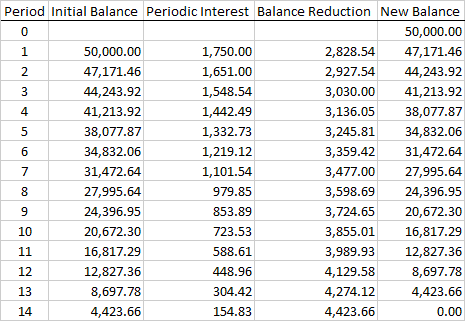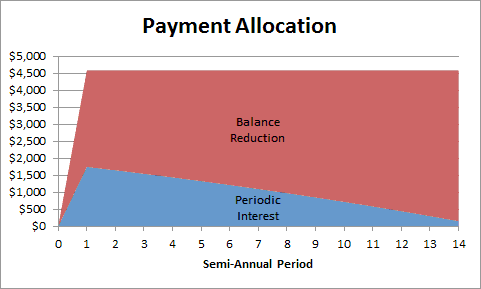

Before going through these examples, you might want to read the section on how to use a calculator.
Consider a 12-month loan of $1,000 at 9% compounded monthly. What are the monthly payments and how much interest will be paid?
M = ?
r = 0.09
ppy = 12
i = r/ppy = 0.09/12 = 0.0075
t = 1
n = (t)(ppy) = (1)(12) = 12
P = 1000
A
I = ?
Notice that the amount of interest paid is off by 3 cents. If the interest payments in the amortization table (back in the main document) are summed, the total interest is $49.43. The table is based on values rounded to the nearest penny and the formulas are not. Consequently, the formula results are sometimes off by a few cents.
The APR is 9.381%:
1.0075^12 - 1 = 0.093806897 = 9.381%
What are the monthly payments on a 25-year mortgage of $100,000 at 8.4% compounded monthly? How much interest is paid?
M = ?
r = 0.084
ppy = 12
i = r/ppy = 0.084/12 = 0.007
t = 25
n = (t)(ppy) = (25)(12) = 300
P = 100000
A
I = ?
No, that is not a mistake! The interest paid on this loan is more than the amount that was borrowed. This becomes less surprising when you consider the first payment. The periodic interest for the first period is 0.007 times 100,000 (the periodic rate times the initial balance) or $700. The amount left for balance reduction is 798.50 - 700 (payment minus interest) or $98.50. As you can see, the vast majority of the first payment goes to pay the interest and only a small fraction is left to reduce the balance owed.
As a matter of fact, for the first 201 payments, the amount that goes to interest exceeds the amount used to reduce the balance. For payment 202, the interest is $398.22 and the balance reduction is $400.28. This is the first time that the balance reduction exceeds the interest.
The illustration below graphically illustrates how the payments are split between interest and balance reduction. The light dotted line indicates that it isn't until payment 202 that the interest is less than the balance reduction.
The APR is 8.731%:
1.007^12 - 1 = 0.087310661 = 8.731%
A family can afford car payments of $175 a month for four years. How much can they borrow at the dealer's special rate of 2.9% (compounded monthly)? How much interest will they pay?
M = 175
r = 0.029
ppy = 12
i = r/ppy = 0.029/12
t = 4
n = (t)(ppy) = (4)(12) = 48
P = ?
A
I = ?
The APR is 2.939%:
(1 + 0.029/12)^12 - 1 = 0.02938858 = 2.939%
Prepare an amortization table for a seven-year loan of $50,000 at 7% compounded semiannually. Create an area chart illustrating how the payments are divided between interest and balance reduction.
For ordinary annuities, the payment periods and the interest periods must be the same. Therefore, we can assume that the payments are made semiannually.
M = ?
r = 0.07
ppy = 2
i = r/ppy = 0.07/2 = 0.035
t = 7
n = (t)(ppy) = (7)(2) = 14
P = 50000
A
I = ?
Remember that the balance reduction is the periodic payment minus the periodic interest. The balance reduction in the last row is set equal to the initial balance which may make the last payment a little bigger or smaller than the rest.

If you add up the values in the interest column, you'll find that the actual interest paid is slightly different from the value given by the formula since the table takes into account the modified last payment and the formula does not. The chart below illustrates how each payment is allocated for interest and balance reduction.

The APR is 7.1225%:
1.035^2 - 1 = .071225 = 7.1225%